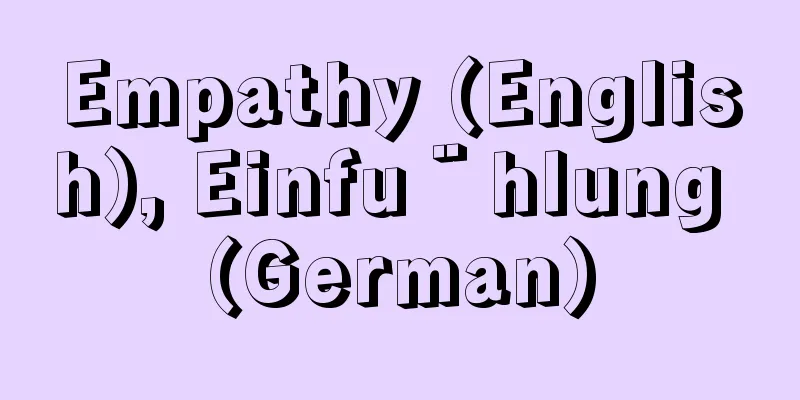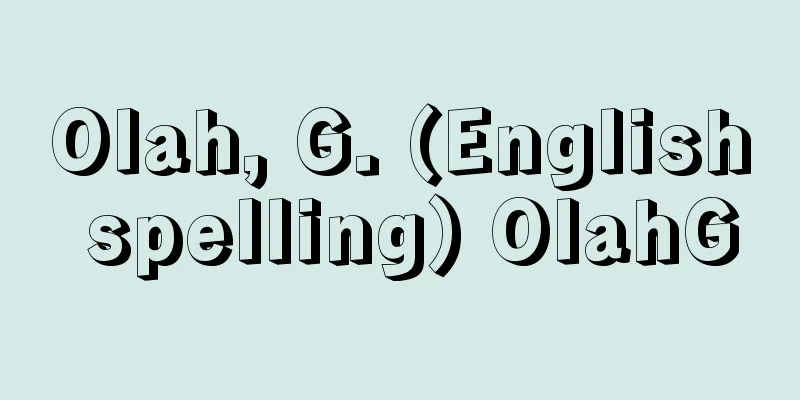Empathy (English), Einfu¨hlung (German)

|
Empathy is the quality or ability to attune oneself to the feelings and emotions of others. In other words, it means thinking about, feeling, understanding, attuned to, and sharing the feelings and experiences of others as if they were one's own. As a result, humans can understand others more deeply. Regarding the definition, according to Sawada Masato (1992), it is believed that the German philosopher Lipps, T. (1903, 1905) began using the concept of Einfühlung (empathy) in the early 20th century to explain the process of being moved by art (the emotional response to the enjoyment of beauty), and interpreted it in a broad sense as a psychological concept of mentally fusing oneself with others. Later, in the United States, Titchener, EB (1909) translated it as empathy, but it is different from the similar term sympathy, which is also used in a positive sense, in that it is limited to the emotion of worrying about others who are in difficult experiences or negative situations such as grief or failure. Regarding whether humans can understand the feelings of others, it is possible for one individual to infer the feelings of another, but this is merely one subject interpreting another's subject, and there is no guarantee that it is accurate. In this way, it is difficult to eliminate ambiguity from the psychological process of empathy, but psychology has understood this to be the foundation of philosophical humanity and has conducted research into it in three major streams. 1. A humanistic or clinical psychology position that is influenced by philosophy or phenomenology and explores the meaning of human empathy, and uses this to help understand humans. ② A position in developmental psychology, evolutionary psychology, and social psychology that primarily takes an evolutionary approach and focuses on the development of the emotional system (module) of empathy and the interpersonal cognitive system. 3) The perspective of neuropsychology and neuroscience that elucidates the mechanisms by which the human brain and hormones create the ability of empathy. [Empathy in clinical psychology] From the perspective of clinical psychology, there is empathic understanding, which is the core of Rogers, CR's (1975) counseling theory. Essentially, there are two parallel processes in understanding a client in counseling. One is an intellectual (external) process in which the counselor (therapist or helper) collects diagnostically objective facts and information about the client (consultant or user). The other is an emotional (internal) process in which the counselor feels (empathizes) the mental contents of the client's experience from the client's perspective, or subjectively grasps them by referring to the counselor's own experiences. In clinical psychology, traditional psychoanalysis places emphasis on the former, placing importance on reported past facts (such as childhood experiences), while the latter places emphasis on the client's current feelings and the counselor's empathic feelings at the core of treatment. Rogers defines empathy as "the therapist's feeling of the client's inner world as if it were his or her own," and believes that this experience promotes treatment. In this way, empathy, which is the ability to share and attune to the feelings and thoughts of others, is considered to be an essential condition for treatment. [Empathy in evolutionary psychology] Evolutionary psychology examines how humans acquired the empathy system. In other words, in the evolutionary process from protemphasis to arboreal protemphasis, they adapted to the environment by improving their survival and defense systems against environmental changes and threats from predators. They first found a niche in the trees and used insects and resin as food resources. Then, by consuming fruits and leaves, they enlarged their bodies and descended to the ground, where there were many dangers. They then evolved collective behavior as a defense against predators. Groups generate stress among individuals, and diverse emotions were developed to reduce this stress and promote affiliative behavior. In addition, as the body size increased, the brain capacity also increased, and a cognitive system that can read the minds of other individuals (theory of mind) evolved. In this way, primates evolved the social brain, as hypothesized by Dunbar, RIM and Barton, RA (1997). Similarly, humans, who evolved from monkeys, use their emotional and cognitive systems to empathize with their children emotionally and cognitively, although this cannot necessarily be said to be weak. According to ethologist Eibl-Eibesfeldt, I. (1972), empathy is innate and is considered to be a mechanism for helping other individuals of the same species. This easily explains parenting, which is the love and trust we have for our children, and parent-child attachment. Furthermore, it is this mechanism of empathy that limits the aggression that humans, like animals, have, and as a result, is thought to be the basis for humans to form collective behavior and bonds. In this way, empathy goes beyond the direct genetic replication of parenting and is also related to the altruistic behavior (indirect reciprocity) and morality that humans have toward other individuals living in groups. It is thought that a foundation of empathy is essential for humans to recognize other individuals, grasp the theory of mind of others, and live an affiliative social life based on that. [Empathy in neuropsychology] Brain research has shown that the anterior cingulate cortex (ACC) of the frontal lobe, which controls cognitive functions such as decision-making and attention, is involved in empathy and emotion. This area is called mirror neurons because it is activated when one feels pain and when one sees another person in pain. The existence of this module that is activated when one mentally imitates the actions of others was revealed by Rizzolatti, G. in an experiment using monkeys, but research by Iacoboni, M. and others has revealed that it also exists in humans, suggesting the neuroscientific basis of the human empathy mechanism. The existence of a system in which babies imitate the facial expressions of their parents (postural echo) has already been confirmed by Meltzoff, AN (1977) and others, and there is no doubt that the existence of such an automatic representation system is innate. However, although empathy is related to mirror neurons in the anterior cingulate cortex, the basis of human emotions is the amygdala, which is located deeper in the limbic system. The insular cortex, which is located in between, also plays an important role, and it is difficult to say that these connections have been fully elucidated. Therefore, it is unreasonable to conclude that the inability to empathize is due to abnormalities in the anterior cingulate cortex, where mirror neurons are located, and it is more appropriate to consider that both the cognitive and emotional mechanisms of the frontal lobe and the limbic system are related. As described above, empathy is considered to be a system related to cognition and emotion. Hoffman, ML (1979), who claims the innateness of empathy, considers the crying of an infant to be emotional contagion, and argues that empathic distress occurs in the recipient as a result of emotional contagion, thus asserting the importance of emotion. Thus, the relationship of empathy to the cognitive mechanisms of the brain and theory of mind has been emphasized, but at present it is difficult to explain empathy with a single measure or definition. The most frequently used scale for assessing empathy is the interpersonal reactivity index (IRI) by Davis, MH (1980). In addition to recent research examining activity in specific brain regions, it has been reported that empathy is also related to the amount of hormones in the brain, such as testosterone and oxytocin. Thus, brain research into the elucidation of the mechanisms of empathy has a short history, and future research is expected. →Emotions and Evolution →Nervous System [Kameshima, Shinya] Latest Sources Psychology Encyclopedia Latest Psychology Encyclopedia About Information |
|
共感とは,他人の気持ちや感じ方に自分を同調させる資質や力を意味する。すなわち,他人の感情や経験を,あたかも自分自身のこととして考え感じ理解し,それと同調したり共有したりするということである。その結果,ヒトは他人のことをより深く理解することができる。 定義については,澤田匡人(1992)によると,20世紀初頭にドイツの哲学者リップスLipps,T.(1903,1905)が,芸術に心を揺り動かされる(美を享受する心の感動)プロセスをEinfühlung(感情移入)の概念を用いて説明し,心の中で他人と自分を融合する心理学概念として,広義にとらえたことが始まりと考えられている。その後,アメリカでティチェナーTitchener,E.B.(1909)によってempathy(共感)へと訳されているが,類似した用語であるsympathy(同情)が,悲痛や失敗など困難な経験やネガティブな状況にある他人を心配する感情に限定されるということで,ポジティブな意味合いでも用いられる共感とは区別される。 ヒトが他人の気持ちを理解しうるのかということに関して,個人の感情を別の個人が推測することは可能であるが,それは主観が別の主観を解釈しているに過ぎず,正確である保証はない。このように共感という心理プロセスからは,曖昧性を排除することが難しいが,心理学ではこれを哲学的な人間性humanityの基礎にあるものとして理解しながら,大きな三つの流れで研究を行なってきた。 ①哲学あるいは現象学的な流れを受け,ヒトが共感することの意味を探究。それを基にヒトの理解に役立てようとする人間学的心理学や臨床心理学の立場。 ②進化的な考え方を主とし,共感という情動システム(モジュール)や対人認知システムの発達に注目する発達心理学,進化心理学,社会心理学の立場。 ③ヒトの脳やホルモンが,共感という能力を作り出すメカニズムを解明する神経心理学や脳科学の立場。 【臨床心理学における共感】 臨床心理学の立場からは,ロジャーズRogers,C.R.(1975)のカウンセリング理論の中核をなす共感的理解がある。元来,カウンセリングにおけるクライエント理解には,二つのプロセスが並行して存在すると考えられる。一つは,カウンセラー(治療者,あるいは援助者)がクライエント(相談者,あるいは利用者)について,診断的に客観的な事実や情報を収集する知的(外的)なプロセスである。他の一つは,クライエントが経験している心の内容を,カウンセラー自身もクライエントと同じ立場で感じ(共感し),あるいはカウンセラー自身の経験などを参考にして主観的にとらえるという感情的(内的)プロセスである。 臨床心理学において,前者にウエイトをおく伝統的精神分析学では,報告された過去の事実(幼児体験など)が重視されるが,後者ではクライエントが抱いている現在の感情やカウンセラーの共感感情が治療の中核とされる。ロジャーズによる共感とは「セラピストが,クライエントの内的世界を,あたかも自分のものであるかのように感じ取る」こととされ,その経験が治療を促進すると考える。このように,他人の気持ちや考えを共有し同調する共感こそが,治療に必須な条件であると考えられている。 【進化心理学における共感】 進化心理学では,ヒトが共感システムをどう獲得してきたのかが検討されている。すなわち,系統発生的には,原モグラが樹上生活する原猿(=サル)への進化過程で,環境の変化や捕獲者による脅威に対して,生存や防衛のシステムを改善しながら環境適応を果たしてきたが,最初は樹上にニッチを見つけ,昆虫や樹脂を食資源として利用した。その後,果実や葉を食用とすることで身体を大型化させ,危険がいっぱいの地上に降りた。そうして捕食者に対抗する防衛手段として進化させたのが,集団行動であった。集団は個体間にストレスを発生させるが,これを低減し,親和行動を促進させるために発達させたのが,多様な情動である。また,身体の大型化に伴って脳の容量も増加し,他の個体の心を読みとる認知システム(心の理論theory of mind)が進化した。こうして霊長類は,ダンバーDumber,R.I.M.とバートンBarton,R.A.(1997)が仮説を立てたところの社会脳social brainを進化させた。 同様に,サルから進化したヒトも情動と認知のシステムを駆使して,必ずしも弱いとは限定できないが,子どもに対して情緒的にも認知的にも共感する。動物行動学者アイブル・アイベスフェルトEibl-Eibesfeldt,I.(1972)によれば,共感性は生得的なものであり,同種の他個体に対する援助メカニズムであると考えている。これに従えば,子どもへの愛や信頼である子育てや親子の愛着が容易に説明できる。さらに,この共感のメカニズムこそが,動物同様ヒトが有していた攻撃性に歯止めをかけ,その結果,ヒトが集団行動や絆を形成する基盤となると考えられる。このように考えると,共感は,子育てという直接的な遺伝子複製を超えて,集団生活をする他個体に対してヒトがもつ利他的行動(間接的な互恵性)や道徳性とも関連する。ヒトが他個体を認識し,他人の心の理論を把持し,それに基づき親和的な社会生活をするうえで,共感による基盤は必須なものと考えられる。 【神経心理学における共感】 脳研究からは,意思決定や注意などの認知機能をつかさどる前頭葉のACC(anterior cingulate cortex)とよばれる前帯状皮質領域が,共感や情動などにかかわっているとされる。この領域は,自分が痛みを感じている場合にも,また自分が見ている他人が痛がっている場合にも同じように活性化することから,ミラー・ニューロンとよばれている。この他者の行為を心的に模倣しているときに活性化するモジュールの存在は,リゾラッティRizzolatti,G.によるサルを使った実験で判明したが,イアコボーニIacoboni,M.たちの研究などからヒトにも存在することがわかり,ヒトの共感メカニズムの脳科学的基盤が示唆された。すでに生後数時間の赤ん坊が親の表情を模倣する(共鳴動作postural echo)システムの存在は,メルツォフMeltzoff,A.N.(1977)らにより確認されており,このような自動的な表象システムの存在は生得的であることは疑う余地もない。 ただ,共感が前帯状皮質でのミラー・ニューロンと関連している事実があるものの,ヒトの情動基盤は,より深い大脳辺縁系にある扁桃体が担っている。また,その中間に位置する島皮質の役割も重要であり,これらの関連が解明されているとはいいがたい。したがって,共感できないのは,ミラー・ニューロンが存在する前帯状皮質異常によると結論づけるのは無理があり,前頭葉と辺縁系の認知や情動メカニズムの両方が関連していると考えるのが妥当である。 以上のように,共感は認知と情動に関連するシステムと考えられる。共感の生得性を主張するホフマンHoffman,M.L.(1979)は,乳児のもらい泣きを情動伝染と考え,情動が伝染される結果,受け手には共感的苦痛が生じるとして,情動の重要性を主張した。このように共感は,脳の認知メカニズムや心の理論との関連が強調されているが,現時点では共感を一つの物差しや定義で説明することは難しい。なお,最も頻繁に使用されている共感の評定尺度は,デービスDavis,M.H.(1980)による対人反応性指標interpersonal reactivity index(IRI)である。最近取り組まれている脳の特定領域での活動量を調べる研究以外では,共感がテストステロンやオキシトシンなどの脳内ホルモン量とも関連することが報告されている。このように共感のメカニズム解明に関する脳研究も歴史が浅く,今後の研究が期待されている。 →情動と進化 →神経系 〔亀島 信也〕 出典 最新 心理学事典最新 心理学事典について 情報 |
Recommend
Figuereido, M.de (English spelling) FiguereidoMde
… In 1549 (Tenbun 18), missionary work in Japan b...
Welsh Mountains - Wales Mountains
...(5) Midland Highlands: A hilly region eroded b...
Presence - Kihai
〘 noun 〙① To be considerate. Thoughtfulness. Atten...
Kong Xiangxi
Republic of China politician and businessman. His ...
Shirakawa
The name of the area around the Shirakawa River, w...
Elephanta Caves - Elephanta Caves
Hindu caves on Elephanta Island in Mumbai (Bombay)...
Nude mouse - Nude mouse (English spelling)
A mouse mutant that is congenitally hairless and ...
Brown-eared bulbul - Brown-eared bulbul
A perennial plant of the Asteraceae family. The u...
QED - Qed
《 quantum electrodynamics 》⇒Quantum electrodynamic...
Cygnus (the Swan)
Its abbreviation is Cyg. It is a major constellati...
chromatid
...When cells undergo meiosis, from pachytene to ...
Malik, Adam
Born: July 22, 1917, Pematangsiantar, North Sumatr...
Adultery - Kantsuzai
This refers to cases where a husband or wife havi...
International Convention for the Safety of Life at Sea
It is abbreviated as the SOLAS Convention. It is a...
Rayon - jinken
It is an abbreviation of artificial silk, also kn...









